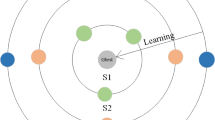Abstract
Considering the complexity of wireless sensor network (WSN) coverage problems, which include many variables and a large continuous search space, a WSN coverage optimization method based on an improved artificial bee colony (ABC) algorithm with teaching strategy is proposed in this paper. ABC, which is good at exploration but poor at exploitation, is improved by introducing a teaching strategy in teaching-learning-based optimization (TLBO) that has a rapid convergence but is easily trapped in a local optima. Thus, the proposed algorithm combines the advantages of ABC strong global search ability and TLBO rapid convergence. In addition, to retain the diversity and eliminate the parameter limit in ABC, a dynamic search update strategy is introduced instead of the scout bee phase of ABC. In addition to preliminary examinations with a number of benchmark functions, the performance of the algorithm is verified by solving a complicated wireless sensor network coverage problem. The simulation results verify that the proposed algorithm achieves better balance between global and local search compared with other state-of-the-art algorithms.







Similar content being viewed by others
Explore related subjects
Discover the latest articles, news and stories from top researchers in related subjects.References
Zhou L, Yang K, Zhou P (2010) Optimal coverage configuration based on artificial fish swarm algorithm in WSNs. Appl Res Comput 27(6):2276–2279
Alia O, Al-Ajouri AJISJ (2017) Maximizing wireless sensor network coverage with minimum cost using harmony search algorithm. IEEE Sens J 17(3):882–896
Song D, Qu J (2017) A fast efficient particle swarm optimization algorithm for coverage of wireless sensor network. In: International conference on computer systems, electronics and control (ICCSEC), pp 514–517
Teaching-learning-based optimization (TLBO) algorithm. https://sites.google.com/site/tlborao/tlbo-code
Deng W, Xu J, Zhao H (2019) An improved ant colony optimization algorithm based on hybrid strategies for scheduling problem. IEEE Access
Tian J, Gao M, Ge G (2016) Wireless sensor network node optimal coverage based on improved genetic algorithm and binary ant colony algorithm. EURASIP J Wirel Commun Netw 2016(1):1–11
Yu W, Li X, Cai H, Zeng Z, Li X (2018) An improved artificial bee colony algorithm based on factor library and dynamic search balance. Math Probl Eng 2018:1–16
Jiang A, Zheng L (2018) An effective hybrid routing algorithm in WSN: ant colony optimization in combination with hop count minimization. Sensors 18(4):1020
Li Q, Yi Q, Tang R, Qian X, Yuan K, Liu S (2019) A hybrid optimization from two virtual physical force algorithms for dynamic node deployment in WSN applications. Sensors 19(23):5108
Fan F, Ji Q, Wu G, Wang M, Ye X, Mei Q (2018) Dynamic barrier coverage in a wireless sensor network for smart grids. Sensors 19(1):41
Zou F, Wang L, Hei X, Chen D, Yang D (2014) Teaching-learning-based optimization with dynamic group strategy for global optimization. Inf Sci 273:112–131
Gunji AB, Deepak BB, Bahubalendruni CR, Biswal DB (2018) An optimal robotic assembly sequence planning by assembly subsets detection method using teaching learning-based optimization algorithm. In: IEEE transactions on automation science and engineering, pp 1–17
Khanduzi R, Ebrahimzadeh A, Peyghami MR (2018) A modified teaching–learning-based optimization for optimal control of Volterra integral systems. Soft Comput 22(17):5889–5899
Rao R, Savsani V, Vakharia D (2011) Teaching-learning-based optimization: a novel method for constrained mechanical design optimization problems. Comput Aided Des 43(3):303–315
Zhou X, Wu Z, Wang H, Rahnamayan S (2016) Gaussian bare-bones artificial bee colony algorithm. Soft Comput 20(3):907–924
Karaboga D (2005) An idea based on honey bee swarm for numerical optimization. Technical report-tr06, Erciyes University, Engineering Faculty, Computer Engineering Department
Zhu G, Kwong S (2010) Gbest-guided artificial bee colony algorithm for numerical function optimization. Appl Math Comput 217(7):3166–3173
Deng X, Yu Z, Tang R, Qian X, Yuan K, Liu S (2019) An optimized node deployment solution based on a virtual spring force algorithm for wireless sensor network applications. Sensors 19(8):1817
Wang B (2011) Coverage problems in sensor networks: a survey. ACM Comput Surv 43(4):32–85
Karaboga D, Akay B (2009) A comparative study of artificial bee colony algorithm. Appl Math Comput 214(1):108–132
Awad NH, Ali MZ, Liang JJ, Qu BY, Suganthan PN (2016) Problem definitions and evaluation criteria for the CEC 2017 special session and competition on single objective bound constrained real-parameter numerical optimization. Nanyang Technological University, Singapore. Technical Report
Qi Q (2012) A coverage algorithm based on probability sensing model in wireless sensor networks. Dissertation, Huazhong University of Science and Technology
Yu W, Li X, Li X, Zeng Z (2017) Constrained relay node deployment using an improved multi-objective artificial bee colony in wireless sensor networks. KSII Trans Internet Inf Syst 11(6):2889–2909
Artificial bee colony (ABC) algorithm. https://abc.erciyes.edu.tr/
Wang YP, Dang CY (2007) An evolutionary algorithm for global optimization based on level-set evolution and Latin squares. IEEE Trans Evol Comput 11(5):579–595
Acknowledgements
This work was supported by the Talent Introduction Foundation of Chengdu University of Information Technology (Grant No. 376148). Moreover, the author conveys his heartfelt gratefulness to the anonymous reviewers and editor for their rigorous work in improving the manuscript.
Author information
Authors and Affiliations
Corresponding author
Ethics declarations
Conflict of interest
The authors declare that they have no conflicts of interest.
Additional information
Publisher's Note
Springer Nature remains neutral with regard to jurisdictional claims in published maps and institutional affiliations.
Rights and permissions
About this article
Cite this article
Lu, C., Li, X., Yu, W. et al. Sensor network sensing coverage optimization with improved artificial bee colony algorithm using teaching strategy. Computing 103, 1439–1460 (2021). https://doi.org/10.1007/s00607-021-00906-0
Received:
Accepted:
Published:
Issue Date:
DOI: https://doi.org/10.1007/s00607-021-00906-0




